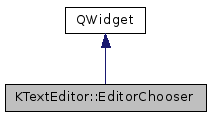KTextEditor
#include <editorchooser.h>

Signals | |
| void | changed () |
Public Member Functions | |
| EditorChooser (QWidget *parent=0) | |
| virtual | ~EditorChooser () |
| void | readAppSetting (const QString &postfix=QString()) |
| void | writeAppSetting (const QString &postfix=QString()) |
Static Public Member Functions | |
| static KTextEditor::Editor * | editor (const QString &postfix=QString(), bool fallBackToKatePart=true) |
Detailed Description
Editor Component Chooser.
Topics:
Introduction
The EditorChooser is responsible for two different tasks: It provides
- a GUI, with which the user can choose the preferred editor part
- a static accessor, with which the current selected editor part can be obtained.
The GUI Editor Chooser
The EditorChooser is a simple widget with a group box containing an information label and a combo box which lists all available KTextEditor implementations. To give the user the possibility to choose a text editor implementation, create an instance of this class and put it into the GUI:
Later, for example when the user clicks the Apply-button:
After this, the static accessor editor() will return the new editor part object. Now, either the application has to be restarted, or you need code that closes all current documents so that you can safely switch and use the new editor part. Restarting is probably much easier.
- Note
- If you do not put the EditorChooser into the GUI, the default editor component will be used. The default editor is configurable in KDE's control center in "KDE Components > Component Chooser > Embedded Text Editor".
Accessing the Editor Part
The call of editor() will return the currently used editor part, either the KDE default or the one configured with the EditorChooser's GUI (see The GUI Editor Chooser). Example:
- See also
- KTextEditor::Editor
Definition at line 88 of file editorchooser.h.
Constructor & Destructor Documentation
| EditorChooser::EditorChooser | ( | QWidget * | parent = 0 | ) |
Constructor.
Create an editor chooser widget.
- Parameters
-
parent the parent widget
Definition at line 53 of file editorchooser.cpp.
|
virtual |
Destructor.
Definition at line 90 of file editorchooser.cpp.
Member Function Documentation
|
signal |
This signal is emitted whenever the selected item in the combo box changed.
|
static |
Static accessor to get the Editor instance of the currently used KTextEditor component.
That Editor instance can be qobject-cast to specific extensions. If the result of the cast is not NULL, that extension is supported:
- Parameters
-
postfix config group postfix string fallBackToKatePart if true, the returned Editor component will be a katepart if no other implementation can be found
- Returns
- Editor controller or NULL, if no editor component could be found
Definition at line 118 of file editorchooser.cpp.
Read the configuration from the application's config file.
The group is handeled internally (it is called "KTEXTEDITOR:", but it is possible to add a string to extend the group name with postfix.
- Parameters
-
postfix config group postfix string
- See also
- writeAppSetting()
Definition at line 96 of file editorchooser.cpp.
Write the configuration to the application's config file.
- Parameters
-
postfix config group postfix string
- See also
- readAppSetting()
Definition at line 110 of file editorchooser.cpp.
The documentation for this class was generated from the following files:
Documentation copyright © 1996-2014 The KDE developers.
Generated on Tue Oct 14 2014 22:52:20 by doxygen 1.8.7 written by Dimitri van Heesch, © 1997-2006
KDE's Doxygen guidelines are available online.
 KDE API Reference
KDE API Reference